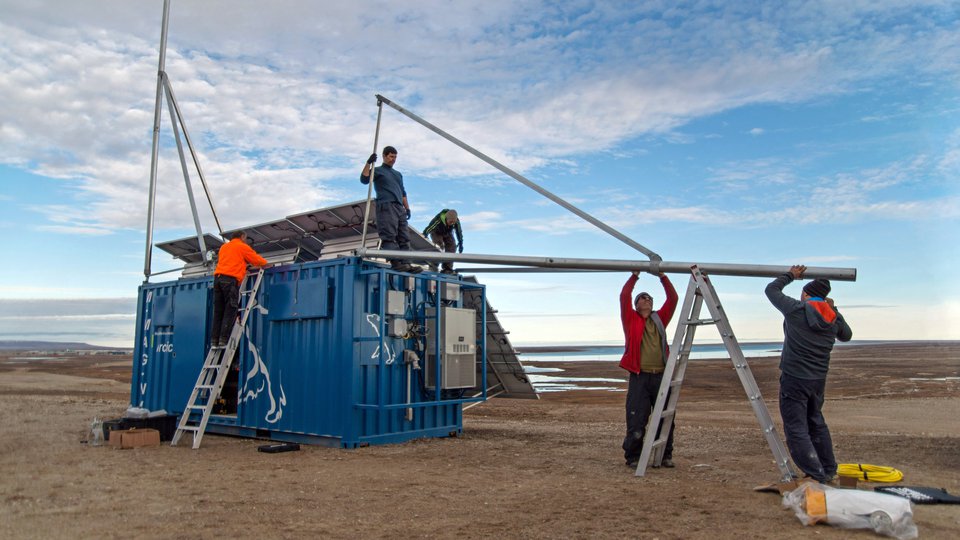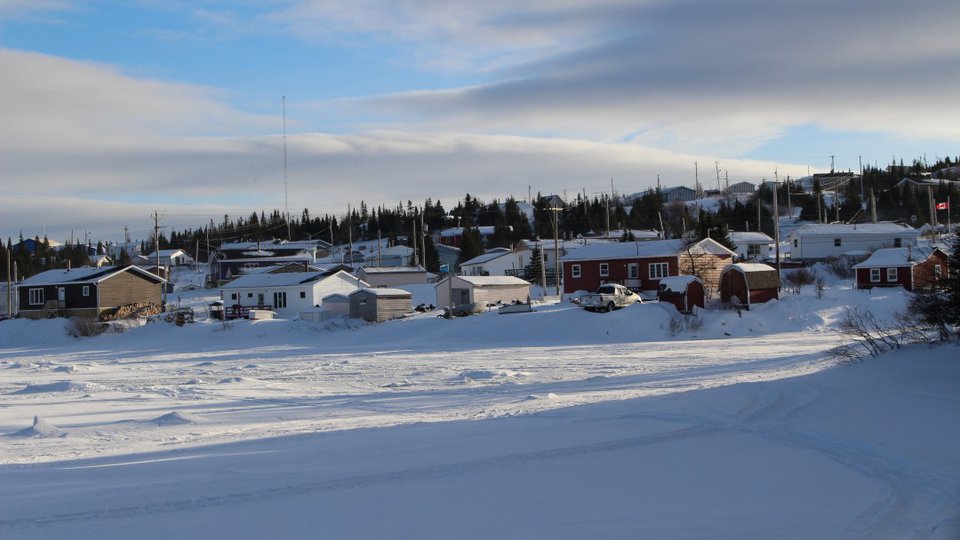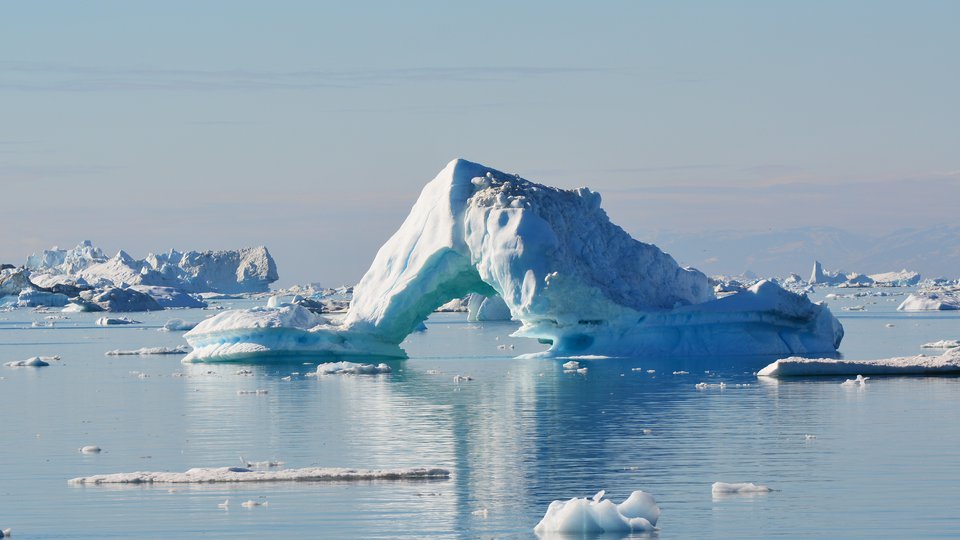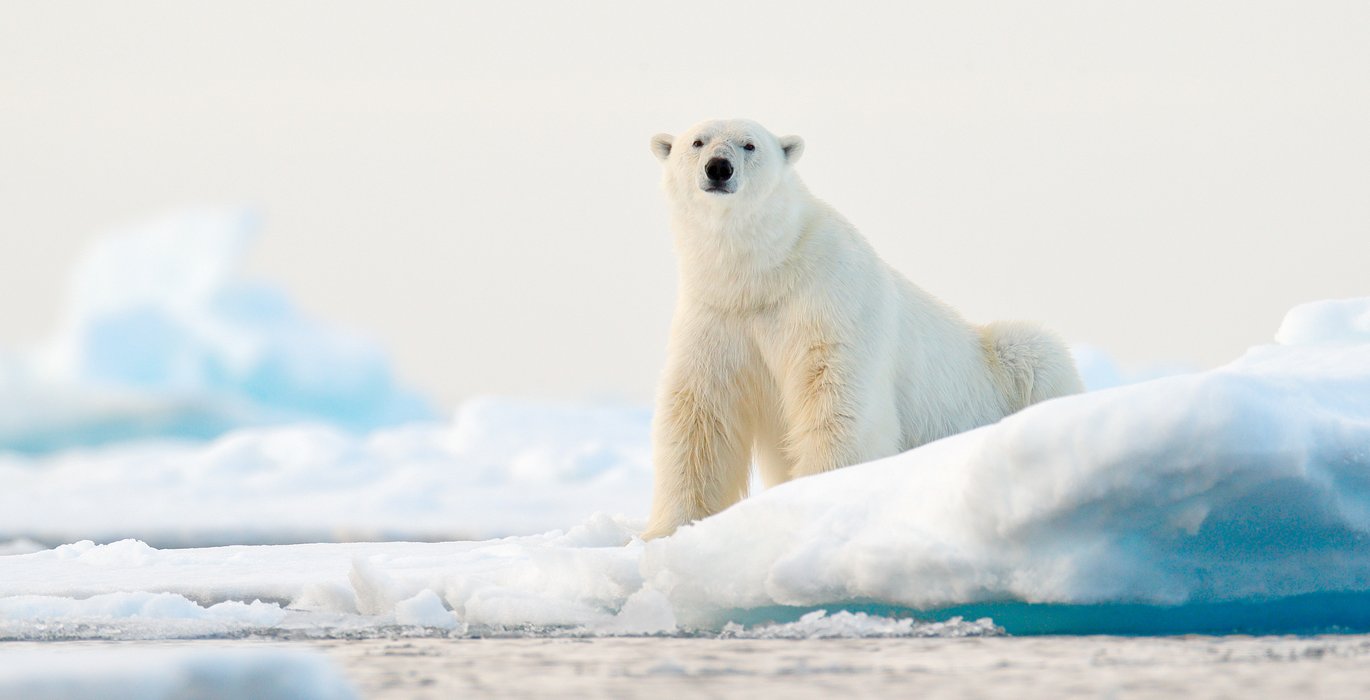
Polar bears have become an icon of climate change because of the impact melting sea ice has on their well-being. However, the loss in Arctic sea ice, and the exact ways it impacts polar bears, is nuanced. Not all polar bears are the same, and not all bears feel these impacts in the same way. Some have yet to feel them at all.
Across the circumpolar Arctic lies the ranges of twenty subpopulations of polar bears, separated primarily based on their movements (1-2). Polar bears both move and behave differently between many subpopulations because the very environment underneath their paws – Arctic sea ice – operates differently across space.
Sea ice is a dynamic, complex substrate on which the entire Arctic marine ecosystem depends (3). For polar bears, it provides the platform from which they can hunt for seals, their main prey (3-5). In 2008, scientists separated the sea ice available to polar bears into four ecoregions (6). Within each ecoregion, sea ice operates similarly, creating unique habitats for polar bears that are thus affected by climate change in different ways.
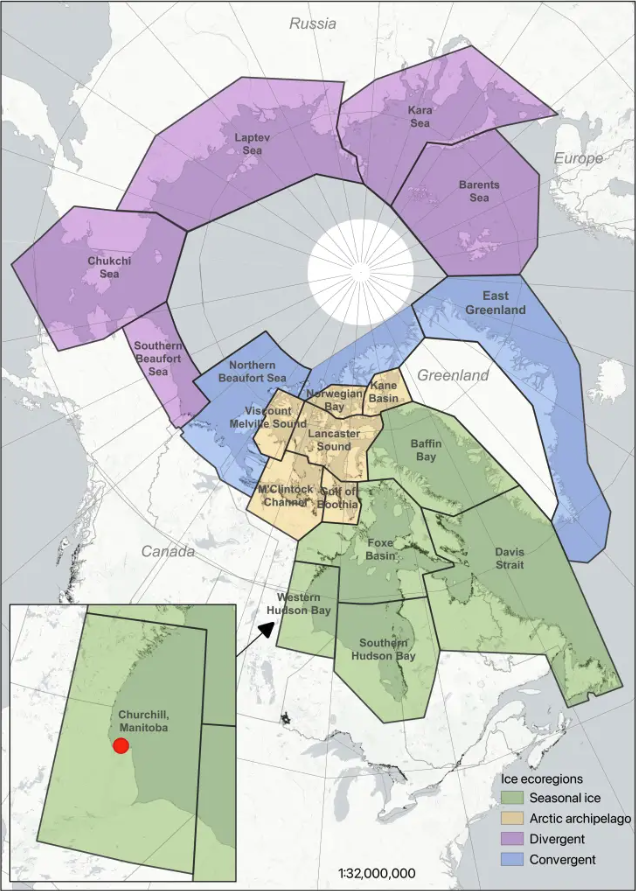
The 20 subpopulations of polar bears separated into the 4 sea ice ecoregions. Scientists separated the Arctic into these different sea ice ecoregions based on how the sea ice itself operates. (Photo" Larissa Thelin)
Seasonal ecoregion
The seasonal ecoregion exists in northeast Canada and Greenland and encompasses sea ice that has four seasons: winter time consisting of prevalent ice in the coldest months, a break-up season in spring when the ice begins to melt away, an ice-free period during the warm months when polar bears are forced on land, and a freeze-up season in autumn (6-7). There are 5 subpopulations here, some of which have experienced the first impacts of climate change due to their southerly extent (6).
Because of earlier break-up and later freeze-up seasons over time, the ice-free season is lengthening (6). Polar bears in this ecoregion adapted long ago to fast during summer, but climate change is forcing them to fast for longer than their bodies are accustomed to, which has caused lower body conditions, decreased survival, and lower reproductive rates in some subpopulations (6, 8).
The Western Hudson Bay subpopulation (WB) is one that is already feeling the effects of climate change today. Joanna Sulich, a behavioural scientist and polar bear expert who has worked in Churchill, Manitoba with Polar Bears International for years, explains, “The WB is one of the most southerly of all polar bear subpopulations… Longer seasonal fasts put a strain on bears’ body condition and make reproduction more difficult. Unfortunately, we can see the effects of recent warmer decades in WB bears now, as the subpopulation is about half the size it was in the 1980s.”
Today, the WB has just over 600 individuals left (9).
More time on land also means more potential for polar bears to encounter humans and when they’re hungry after fasting for longer than they’re accustomed to, this can cause concern for people who live among them.
Georgina Berg is a Knowledge Keeper and Elder from the York Factory Cree Nation whose unceded territory surrounds western and southern Hudson Bay. Her parents moved to the Churchill area in the 1950s, but her ancestral roots have been planted in the greater Hudson Bay area for hundreds of years.
“When I was a little girl, we used to be able to go out for Halloween quite safely without the big production like they have nowadays... They control the perimeter of the town, and they have this safety in place, which is needed because we know that polar bears are roaming around. But once upon a time, you’d know that after a certain date the bears were gone, and you could walk around without having to check all the time or worry about your kids.”
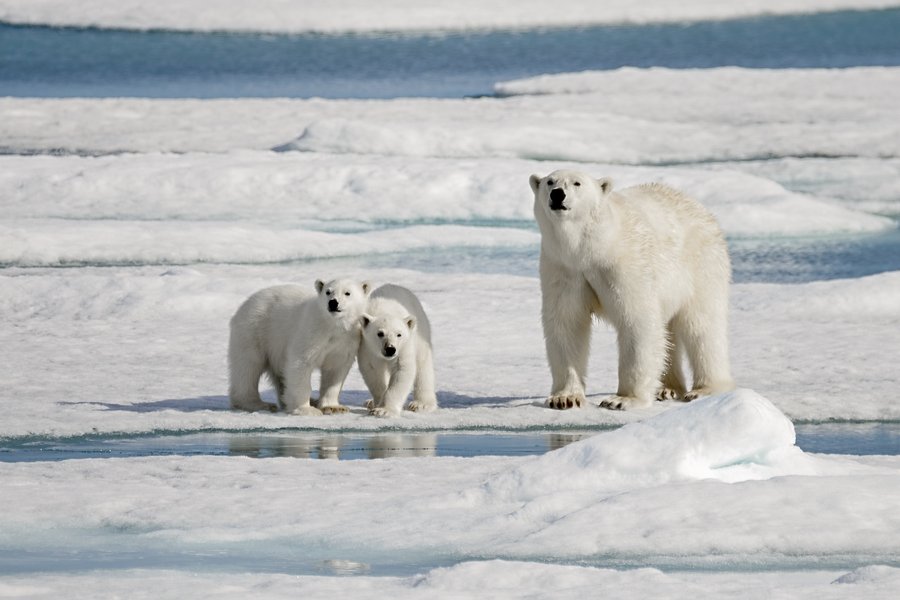
The seasonal ecoregion exists in northeast Canada and Greenland and encompasses sea ice that has four seasons. (Photo: Adobe Stock)
Something interesting is happening in other areas of Hudson Bay, however. Geoff York, Senior Director of Research and Policy at Polar Bears International, explains that James Bay, the most southerly portion of Hudson Bay, may be home to a subpopulation that has not yet been recognized.
“There’s increasing evidence that something unique is happening [there], that there are unique oceanographic conditions that are allowing… a high Arctic ecosystem, to persist so far South, to the point where… it’s host to a polar bear subpopulation that doesn’t seem to leave there. Ever.”
This new research suggests that when the ocean provides high biodiversity and sea ice conditions allow polar bears to access it, they do not need to travel far to live well. “[This] small group of bears has decided that… their best bet is to just stay put”, he explains.
These bears may have successfully created a living for themselves apart from the rest of the polar bears in Hudson Bay, but “[a]s it goes, nobody's going to be able to survive what's predicted to come for the seasonal sea ice area, which is no ice at all,” says York, and models suggest that they may not have much time left (10).
York was a co-author on a recent study that proved that unless we abide by the Paris Agreement, we may soon see the localized extinction of most polar bears within Hudson Bay (10). Regardless of small areas of high prey availability, polar bears need sea ice to access it, and that ice may be too thin to support polar bears’ movements as early as 2030 (10).
Berg expressed deep sadness when hearing about this new research, “When you’ve lived with them, they’re almost like family. You care about their existence… The polar bears remind me of the Indigenous people. We’re like one with them, because we’ve been through similar hardships – hunger, land changing that determines how we live. So, we really consider them family and if they were not here anymore, it would be a loss.”
Divergent ecoregion
The divergent ecoregion surrounds the Norwegian, Russian, and Alaskan portions of the polar bear ranges. It is characterized by sea ice that forms along the coast but is constantly pulled from shore by ocean currents (6-7).
There are only two seasons of sea ice here: cold, winter months with prevalent ice, and warm months when new ice does not form, creating a gap between land and the polar ice cap to the north (7). Five polar bear subpopulations are found here, but the differences between them are not just attributed to sea ice, but also to the depths of the ocean below.
“In the Southern Beaufort [Sea subpopulation (SB), there is] a very thin continental shelf, which then quickly drops off into the deeper ocean, and is presumably less productive. The Chukchi Sea [subpopulation] is radically different; it's a huge, shallow continental shelf all the way across between Alaska and Russia and would fall similarly to the Barents Sea [subpopulation] in being what oceanographers would call 'hyper-productive',” explains York.
Because of the high biological productivity in the Chukchi Sea, the subpopulation is faring quite well. Right next door, and likely in part because of deeper, less productive waters, SB bears are experiencing the opposite.
“[SB] bears are not doing well, broadly speaking; we've seen a dramatic decline in those bears, whereas [the bears in] Chukchi Sea… have been able to maintain much better, and the theory there is buffering from that hyper-productivity,” explains York. Sea ice loss also plays a major role in the decline of SB polar bears (1).
Even with its high biological productivity, the Barents Sea subpopulation (BS), also within the divergent ecoregion, is seeing negative impacts because of changes in the sea ice – it’s experiencing the most extreme sea ice loss of all subpopulations (11).
“Within the BS, polar bears have two distinct ways of adapting to seasonal changes in sea ice extent”, says Sulich, who has also lived and worked in Svalbard, an archipelago within the subpopulation.
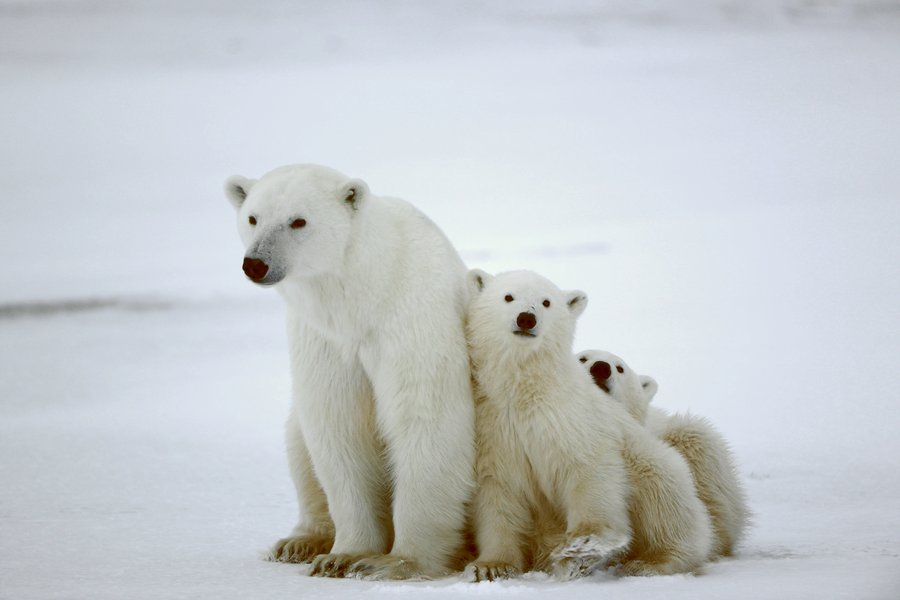
The convergent ecoregion lies opposite the divergent and collects all the sea ice that ocean currents move across the basin. (Photo: Adobe Stock)
“‘Coastal bears’, stay close to the shores of Svalbard… and hunt close to land and glacier fronts. ‘Offshore bears’ venture far out into the sea ice, following its retreat during the annual migration. Sea ice loss due to climate change forces offshore bears to travel longer, [sometimes] forcing [them] to swim longer distances [and burn] more energy. Or the ice may move over deep, unproductive waters, resulting in poorer hunting grounds… Coastal bears, [on the other hand], are facing less sea ice days and are feeding on less energetically rich land-based prey.”
Coastal polar bears in the divergent ecoregion never had to learn how to fast during summers like those in the seasonal ecoregion yet are now experiencing similar ice-free seasons that force them to (7). Some of them are even learning to hunt reindeer, although scientists warn that this is not a long-term solution (12-13).
Convergent ecoregion
The convergent ecoregion lies opposite the divergent and collects all the sea ice that ocean currents move across the basin (6). Because of this and the sea ice created here, its subpopulations have access to ice year-round and are not forced on land and into a fasting period (7). Unfortunately, the polar bears here have not been studied well enough to know what their numbers are today (1). Just two subpopulations were found here, up until recently when a third was discovered.
The most isolated and genetically distinct subpopulation has recently been found in southeast Greenland (2). Different than any other subpopulation, and because sea ice is often sparse here, these bears have discovered a way to successfully hunt from fresh, glacial ice instead (2, 14) – behaviour that shocked polar bear scientists (15). More surprisingly, according to genetic sampling, they’ve been doing so for about 200 years (15).
Archipelago ecoregion
Finally, the archipelago ecoregion encompasses shallow pockets of water between Canada’s most northern islands (7). Sea ice here remains frozen throughout the year and like the convergent zone, provides year-round habitat for polar bears (7). Six subpopulations call this ecoregion home, but many of them are not well studied.
From the little we know, it is clear that sea ice here is thinning, creating favourable conditions for polar bears (7). Multiyear ice that was too thick for much life to persist beneath its surface has thinned, causing an increase in productivity and thus more food for polar bears (7). Because of this, two subpopulations may have increased, although scientists warn that these are likely short-term trends (1).
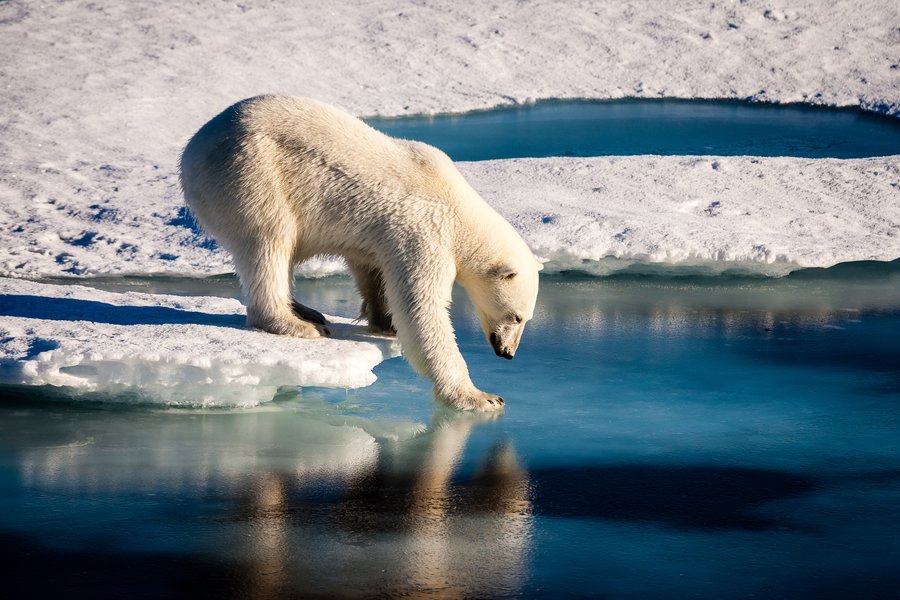
The archipelago ecoregion encompasses shallow pockets of water between Canada’s most northern islands. (Photo: Adobe Stock)
The challenges that polar bears face across the Arctic vary across space. But from time to time, there are glimpses of hope – polar bears that can persist far south in James Bay because of high ocean productivity or that learn to hunt reindeer in Svalbard, sea ice that persists through the year or is thinning to perfect conditions and may provide a refuge in years to come, or even some bears that have apparently been hunting without the need for sea ice at all.
But York warns that this is false hope, “thinking about [these things] makes you feel a little bit happy, knowing that there are these pockets where something different is happening, something unexpected… It’s really cool that you can see behavioural plasticity and that it can work out… but for how long?”
Yes, there are hopeful stories, but those few surprisingly, successful polar bears don’t paint the full picture. Even for polar bears that use glacial ice instead of sea ice, the need for ice itself is still there – and both fresh and salt versions of it are melting. Continued warming will eventually cause the loss of the Arctic ice cap, and thus eradicate the habitat of polar bears entirely.
That is, unless we do something about it.
“This is real, this is happening now, this is being documented in real-time, these dramatic impacts to [polar bears’] survival”, warns York. He explains that even the models that estimate future ice conditions for polar bears “are inherently conservative… [They are not] radical models that are predicting worst case scenarios. If anything, they tend to underestimate impacts over and again.” In short, polar bears will likely fare worse than our models can predict.
“Nothing that you do, feel, or think is without an effect,” says Sulich. It’s time for everyone to take this seriously, to take stock of their lives and learn how they are playing a role in climate change.
Berg wonders what exactly that might look like, “We need to be educated more about how we take care of our Earth. Everybody has a part in climate change, but we need to know what that part is. A lot of people would probably be more willing to help if they just knew how they could help.”
She suggests that parents and teachers have an obligation to involve children – “[they] need to start speaking [to children] about polar bears or our climate. We have to give kids a purpose, and climate change would be a really good purpose.”
But the mitigation of climate change cannot fall on the shoulders of the next generation alone – by then, it may be too late. The biggest thing we can each do today to help with climate change mitigation, York explains, is to “vote for politicians at all levels of government that understand the value of science and the role it has in policy.”
Politicians have the power to enact system-level changes that can reduce emissions on a large scale. But they must involve locals in the process.
“Indigenous people have always thought of themselves as caretakers of the Earth”, says Berg, “we take care of Mother Earth and She takes care of us… [Politicians] need to be asking people what they think, especially people that live with polar bears. The polar bears can’t speak for themselves, but the people who live with them can speak for them.”
A collaborative, cooperative approach may be the best way forward – climate change education at all levels, meaningful conversations with those that already feel the impacts or are watching their faunal family members suffer, and especially, political agency and action.
Literature cited
- IUCN/SSC Polar Bear Specialist Group. (2023). Status report on the world’s polar bear subpopulations. Retrieved from: https://www.iucn-pbsg.org/wp-content/uploads/2024/01/PBSG-Status-Criteria-and-Report_Final_2023Oct17.pdf
- IUCN SSC Polar Bear Specialist Group. (2024). 20th Working meeting of the IUCN/SSC Polar Bear Specialist Group. Retrieved from: https://www.iucn-pbsg.org/2024/06/18/20th-working-meeting-of-the-iucn-ssc-polar-bear-specialist-group/
- Lehner, F. (2024). Key facts about Arctic sea ice. Retrieved from: https://polarbearsinternational.org/news-media/articles/arctic-sea-ice-key-facts
- Stirling, I. & Derocher, A.E. (1993). Possible impacts of climate warming on polar bears. Arctic, 46(3): 240-245. Retrieved from: https://www.jstor.org/stable/40511411
- Derocher, A.E., Lunn, N.J., & Stirling, I. (2004). Polar bears in a warming climate. Integrative and Comparative Biology, 44(2): 163-176. Retrieved from: https://www.jstor.org.stable/3884664
- Amstrup, S.C., Marcot, B.G., & Douglas, D.C. (2008). A Bayesian network modeling approach to forecasting the 21st Century worldwide status of polar bears. Pages 213-268 in Eric. T. DeWeaver, Cecilia M. Bitz, and L.-Bruno Tremblay Eds. Arctic Sea Ice Decline: Observations, Projections, Mechanisms, and Implications. Geophysical Monograph 180. American Geophysical Union, Washington DC.
- Amstrup, S.C. (2021). Four sea ice ecoregions. Retrieved from: https://polarbearsinternational.org/news-media/articles/sea-ice-arctic-habitat-ecoregions
- Molnár, P.K., Bitz, C.M., Holland, M.M., et al. (2020). Fasting season length sets temporal limits for global polar bear persistence. Nature, 10: 732-738. doi: 10.1038/s41558-020-0818-9
- Atkinson, S.N., Boulanger, J., Campbell, M., et al. (2022). 2021 Aerial survey of the Western Hudson Bay polar bear subpopulation. Nunavut Department of Environment, Wildlife Research Section. Igloolik NU.
- Stroeve, J., Crawford, A., Ferguson, S., et al. (2024). Ice-free period too long for Southern and Western Hudson Bay polar bear populations if global warming exceeds 1.6 to 2.6 °C. Communications Earth & Environment, 5(296). doi: 10.1038/s43247-024-01430-7
- Stern, H.L., & Laidre, K.L. (2016). Sea-ice indicators of polar bear habitat. Cryosphere, 10: 2027-2041. doi: 10.5194/tc-10-2027-2016
- Polar Bears International. (n.d.). Barents Sea polar bears. Retrieved from: https://polarbearsinternational.org/what-we-do/research/barents-sea-polar-bear-population/
- Bechshoft, T. (2022). Can polar bears go terrestrial? (The short answer: no). Retrieved from: https://polarbearsinternational.org/news-media/articles/can-polar-bears-live-on-land
- Laidre, K.L., Supple, M.A., Born, E.W., et al. (2022). Glacial ice supports a distinct and undocumented polar bear subpopulation persisting in late 21st-century sea-ice conditions. Science, 376(6599): 1333-1338. doi: 10.1126/science.abk2793
- Mulvaney, K. (2024). How scientists discovered a new polar bear population. Retrieved from: https://polarbearsinternational.org/news-media/articles/how-scientists-discovered-a-new-polar-bear-population
